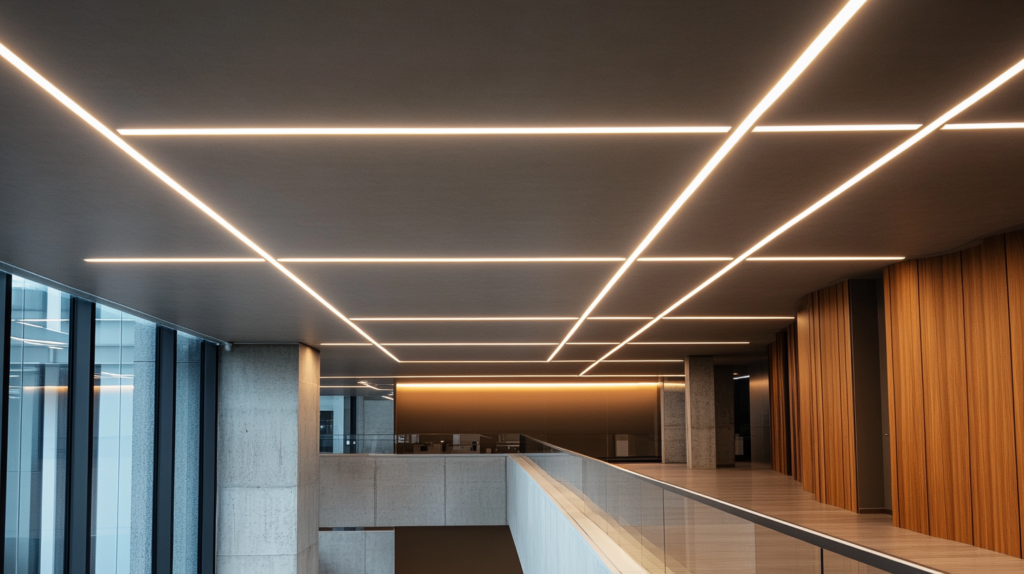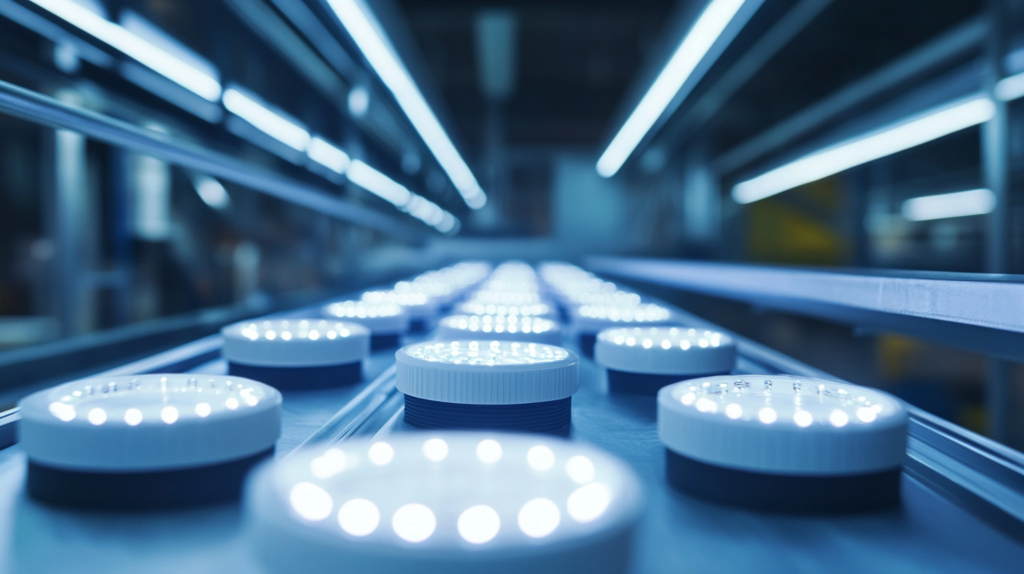What Total Harmonic Distortion (THD) Means In Lighting April 29, 2025 – Posted in: Lighting Information, Commercial Lighting

Many building owners struggle with flickering lights and power issues but don’t know THD might be the cause. Total Harmonic Distortion (THD) measures how much a voltage or current signal is distorted by harmonics.
This blog will explain what THD in lighting means, why it matters for your LED fixtures, and how proper testing can solve these problems. Read on to make smarter lighting choices.
Key Takeaways
- THD (Total Harmonic Distortion) measures how much an electrical signal differs from a perfect sine wave, with 0% being ideal.
- High THD in LED lighting causes flickering, shorter fixture life, higher energy bills, and interference with other devices.
- Quality LED products should have THD under 20%, while industrial lighting needs even lower levels (under 5%).
- You can measure THD using tools like power analyzers, oscilloscopes, and clamp meters with THD functions.
- Installing quality filters, using LED drivers with THD reduction, and adding line reactors can cut distortion by up to 40%.
What is Total Harmonic Distortion (THD) in Lighting?

Total Harmonic Distortion (THD) measures how much a voltage or current signal differs from a perfect sine wave. In lighting systems, THD tells us how much distortion exists in the power drawn by LED fixtures.
This ratio compares the sum of harmonics to the main frequency value. A perfect sine wave has 0% THD, while real-world lighting products show higher values. The electrical testing labs that grant UL certification check THD levels because high distortion can cause problems in buildings.
THD is not just a technical spec – it’s a key indicator of how your lighting will interact with your entire electrical system.
LED lighting must meet certain THD limits to earn safety certification from nationally recognized testing laboratories. The IEC61000-3-2 standard caps THD at the 40th harmonic for lighting products.
High THD can create heat, reduce efficiency, and cause interference with other electrical components. For commercial lighting applications, lower THD values mean better performance and fewer compatibility issues with building systems.

Why THD Matters in LED Lighting
High THD levels in LED lighting can cause flickering and reduce the lifespan of your fixtures. Poor power quality from excessive harmonics affects both your energy bills and the performance of other electrical devices in your building.
Impact on performance and efficiency
High THD levels hurt LED lighting performance in several ways. LED fixtures with poor THD ratings draw more power than needed, raising energy costs and reducing efficiency. The IEC61000-3-2 standard limits THD to the 40th harmonic for good reason – fixtures that exceed these limits can cause problems throughout your electrical system.
Poor THD creates heat that shortens bulb life and may cause flickering or dimming issues. This matters most in commercial spaces where many lights run at once, as the combined effect can strain power systems.

Testing labs like UL and ETL check THD levels during safety testing to make sure lights meet proper standards.
Lower THD ratings (under 20%) mark quality LED products that work better with other equipment. These lights run cooler, last longer, and save money on energy bills. The third-party testing process helps lighting designers pick products that meet safety requirements while delivering top performance.
Energy Star certified lights must pass strict THD tests to earn their rating. For building owners focused on both safety and cost savings, choosing lights with low THD ratings makes a big difference in day-to-day operations and long-term maintenance needs.
Acceptable THD ranges for lighting systems
Acceptable THD ranges for lighting systems vary based on industry standards and application requirements. These ranges help ensure lighting products operate correctly without causing issues in power systems.
| Application Type | Acceptable THD Range | Regulatory Standard | Notes |
|---|---|---|---|
| Residential LED Lighting | <20% | IEC61000-3-2 | Lower THD creates less interference with home electronics |
| Commercial Lighting | <10% | ANSI C82.77 | Stricter limits due to more complex power systems |
| Industrial Lighting | <5% | IEEE-519 | Very low THD needed to protect sensitive equipment |
| Street Lighting | <15% | IEC61000-3-2 | Balance between cost and performance |
| Emergency Lighting | <20% | UL924 | Must maintain performance during power quality issues |
| Premium LED Fixtures | <8% | Energy Star | Higher quality drivers reduce harmonic distortion |
| Basic LED Lamps | <30% | IEC61000-3-2 | Maximum limit per international standards |
The IEC61000-3-2 standard limits THD to the 40th harmonic for lighting systems. This measurement helps assess LED fixture compatibility with power distribution systems. Many manufacturers now design LED drivers with THD values under 20% to ensure reliable operation and reduce interference risks. The exact THD limit depends on the specific application and local electrical codes.
How to Measure and Reduce THD in Lighting

Measuring THD requires specific tools like power analyzers and harmonic analyzers that connect directly to lighting circuits. You can reduce THD in lighting systems through proper driver selection, installing line reactors, or using active harmonic filters that meet UL safety standards.
Tools for measuring THD
Measuring Total Harmonic Distortion helps ensure your lighting systems meet safety standards and work well with other equipment. You need the right tools to check THD levels in your lighting fixtures.
- Power Quality Analyzers – These devices measure THD directly from electrical outlets or lighting circuits. They display readings as percentages and can track changes over time.
- Oscilloscopes – These tools show the actual waveform of your electrical signal. You can spot distortion visually and calculate THD from the displayed waves.
- Harmonic Analyzers – These specialized tools focus only on measuring harmonics in electrical systems. They offer detailed reports about each harmonic up to the 40th level as required by IEC61000-3-2 standard.
- Clamp Meters with THD Function – These portable devices let you check THD without disconnecting any wires. Simply clamp them around power cables to get quick readings.
- Power Meters – Many modern power meters include THD measurement features. They track both energy use and power quality issues.
- Spectrum Analyzers – These devices break down electrical signals into their frequency components. They show exactly which harmonics cause the most distortion.
- Digital Multimeters with THD – Some advanced multimeters now include THD testing abilities. They serve as affordable options for basic THD checks.
- THD Testing Software – This software works with data acquisition hardware to analyze electrical signals. It offers detailed reports and can store data for long-term tracking.
Techniques to minimize THD levels

Reducing THD levels in your lighting systems improves performance and cuts down on electrical issues. These practical methods can help you achieve lower THD and create more efficient lighting setups.
- Install quality power filters that trap harmonic currents before they enter your main power system. These filters act like traffic cops for your electrical current, letting good current through while blocking the bad.
- Use LED drivers with built-in THD reduction features to keep distortion under 20%. Many UL listed and ETL certified drivers now come with this technology standard.
- Add line reactors to your lighting circuits to smooth out current flow and reduce harmonic feedback. These simple devices can cut THD by up to 40% in many lighting systems.
- Choose lighting fixtures with power factor correction (PFC) circuits that naturally limit harmonic distortion. The IEC61000-3-2 standard requires this feature in quality lighting products.
- Upgrade to balanced three-phase power systems for large lighting installations to distribute harmonic loads more evenly. This approach works well for commercial lighting setups.
- Replace magnetic ballasts with electronic ballasts in fluorescent systems to reduce THD from 40% down to 10-15%. This swap also improves energy efficiency.
- Implement isolation transformers between sensitive equipment and lighting circuits to block harmonic transfer. These transformers create a safety barrier that protects both systems.
- Check for loose connections in your lighting system since they can create resistance points that increase THD. Regular testing with proper tools catches these issues early.
- Space lighting circuits evenly across different phases of your power supply to prevent harmonic buildup. This technique works like spreading weight evenly across a bridge.
- Consult with electrical safety experts who understand lighting standards and can suggest custom solutions for your specific setup. Testing laboratories can verify your results meet proper standards.
I have been the project manager for Modern.Place since early 2016, spending three of those years working overseas on the manufacturing & procurement side of the LED lighting industry. Constantly learning and passing on knowledge to others while excited for what the lighting industry will involve into next.

